1
Muscles for the Ballroom – Fitness Training for Dancesport:
Suck It In.
Text: Kerstin Lange Photography and illustrations: Helmut Römhild
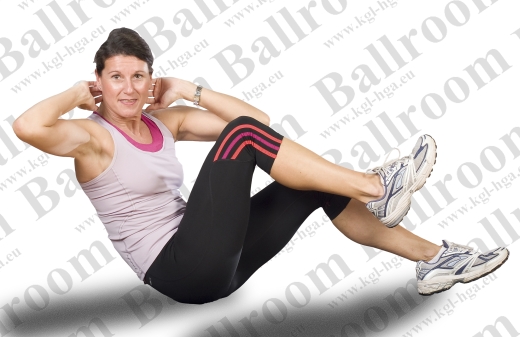
Bicycle Crunches.
Characteristic for the ballroom dancer is the straight, upright body – and a flat stomach.
Sucking in the belly somehow seems to improve the dancing and makes the dancer look fit and competent and ready to meet the challenge.
In fact good looks are only a side effect.
The midsection of the body, the area between chest and pelvis, is fundamental to control the position of the center of gravity while moving across the floor.
‘Sucking in the belly’ really means to contract the muscles between chest and pelvis so they
can counter the force of the muscles of the back and also the pressure and weight of the inner organs.
But very often those muscles are too weak to work properly and instead of improving the dancing skills the
dancer fights a hollow back and a bulging belly.
The midsection is essential for a correct posture but is hard to control.
The part of the body between ribcage and pelvis, the midsection, has no solid bone structure: it is ‘soft’.
The only ‘hard’ element is the spinal column which is in fact also flexible and needs support from muscles to keep its
correct shape.
Stability is provided by the muscles in front, the abdominal muscles, and the muscles of the back.
They work together to create rigidity and at the same time flexibility:
with the midsection the dancer generates balance and stability.
And the midsection is also used to rotate the upper body while he shoulders stay relaxed.
Unfortunately the abdominal muscles are weaker than the muscles of the back and they become weaker over time while the muscles of the back become shorter.
The result is that the muscles of the back start to bend the lower part of the spinal column so it arches forward while tilting the front of the pelvis downward.
The result: a hollow back, a bulging belly.
In other words: the bulging belly as well as the hollow back indicate that the abdominal muscles are too weak to do their work.
The dancer‘s performance degrades and the danger that the spinal column is injured increases.
Workout in Dancesport.
The seemingly effortless way of ballroom dancers to move to the music is a result of considerable fitness. Already the basics of correct posture require strength and an optimised coordination of ligaments,
tendons and muscles.
Dancing alone is not enough to improve strength and mobility.
On the contrary: dancing means to make the system of muscles, tendons, and ligaments work for hours and hours, relentlessly
exploiting the individual possibilities and pushing beyond.
You have to work out to compensate the demands of your sport and to match your rising aspirations as a dancer.
In a short series of articles Ballroom will explain the anatomy involved and discuss exercises to improve
mobility, build up strength, and avoid injuries.
Fitness Trainer Ute Römhild, Trainer Assistant Marc Moder and model Martina contribute expert knowledge and show how to work out effectively.
Incorrectly performed exercises can damage your health!
Consult a fitness instructor before starting to exercise and exercise under supervision of a fitness instructor.
Expert advice is provided by Ute Römhild and Marc Moder.
Ute Römhild
Fitnesstrainer
TSV Glinde von 1930 e.V.
www.tsv-glinde.de
Marc Moder
Trainer Assistant
TSV Glinde von 1930 e.V.
www.tsv-glinde.de
The the pictures were taken at the fitness studio of sportsclub TSV Glinde. We are grateful for the generous support.
TSV Glinde von 1930 e.V.
www.tsv-glinde.de
Seven main abdominal muscles support und move the mid-section of the body:
The rectus abdominus runs from the ribcage to the front of the pelvis.
The muscle is vertically and horizontically subdivided and training makes the structure visible under the skin, the so
called 6-pack.
Its main funtion is to bend the upper body forward and to lift the front of the pelvis.
Also visible under the skin are the external oblique muscles, one on each side of the abdomen.
They connect the muscles of the back with the rectus abdominus.
They help to rotate and to bend the upper body forward.
There are 2 more muscles on each side of the trunk covered by the external muscles.
They connect the muscles of the back with pelvis, ribcage and rectus abdominus.
The internal oblique muscle fans out across the lower abdomen und the side of the trunk.
It bends the body forward and sideways und helps to rotate the trunk.
The transverse abdominus supports the midsection like a corset.
It forms the deepest layer of muscles and is covered by the internal oblique muscle.
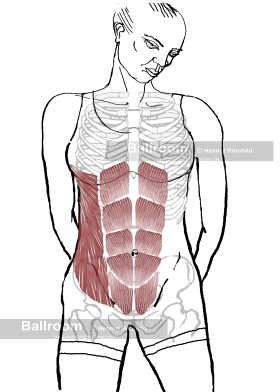
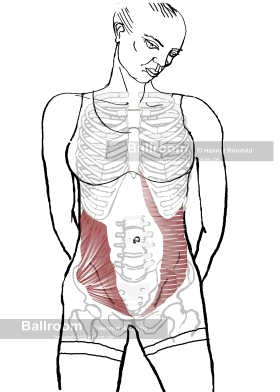
Training of the abdominal muscles is vitally important for a dancer.
Strong abdominal muscles counter the pull of the back’s muscles.
They protect the spinal column and are the dancer’s tool to stay well balanced.
There is one basic exercise to work out the abdominal muscles: the Crunches.
And most effective are the so called ‘Bicycle Crunches’:
| • | Lie on on your back, raise your arms and touch the sides of your head with the fingertips. |
| • | Contract the abdominal muscles, thus lifting your upper body. At the same time bend one knee, bringing it towards your face. |
| • | Rotate the trunk and touch the knee with the opposite elbow, e.g. the right knee with the left elbow. |
| • | Lower the leg, lower the upper body while rotating back, lie down again or better stay slightly obove the floor and repeat the exercise using the other knee. |
Only use the abdominal muscles to go through the moves!
Use them slowly and deliberatly.
Simple, but far from easy.
And almost impossible when doing the exercise for the first time.
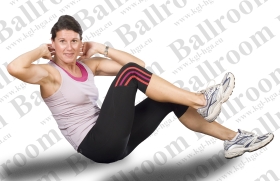
More training – and some things to avoid ...
Side pulls with weights or elastic bands focus on the abdominal muscles at the side of the body.
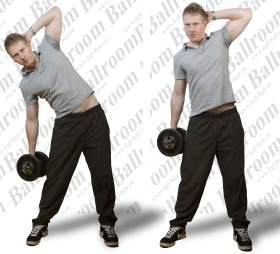
They train the abdominal muscles together with the muscles of the back and help to increase flexibility.
... and never do Sit-Ups with straight and fixed legs.
These exercises are dangerous for the spinal column and have only little effect on the abdominal muscles!
on a declined bench or a Slant-Board are exercises for fully trained and experienced athletes.
A second person or, better, a fitness instructor should be present to immediately correct any mistakes.
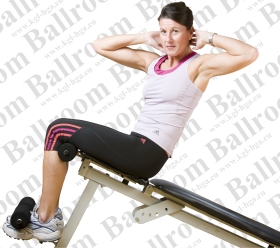
![]()
©: Ballroom Website, 2011
Updated: 12.06.2011





